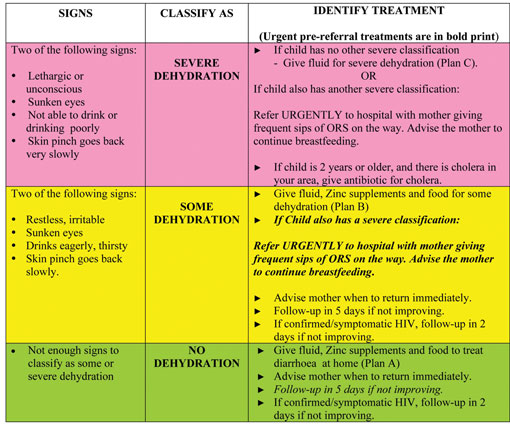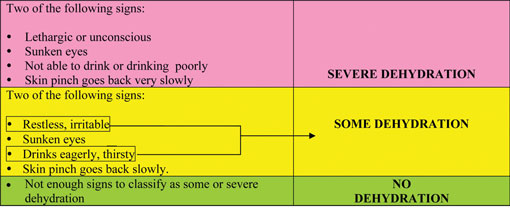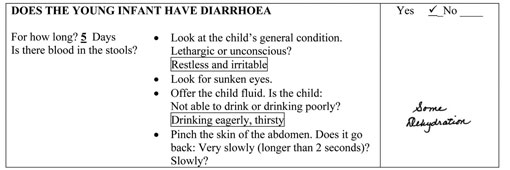5.3.1 Classifying dehydration
There are three possible classifications of dehydration in a child with diarrhoea:
- Severe dehydration
- Some dehydration
- No dehydration.
The relevant section from the Assess and Classify chart booklet is set out in Table 5.1. The treatment plans A, B and C referred to in the third column are explained in Section 5.4 below.
Table 5.1 Classification of dehydration in a child (1).
To classify the child’s dehydration, begin with the top (pink) row.
- If two or more of the signs in the pink row are present, you should classify the child as having SEVERE DEHYDRATION.
- If two or more of the signs are not present, look at the middle (yellow) row. If two or more of the signs are present, you should classify the child as having SOME DEHYDRATION.
- If two or more of the signs from the yellow row are not present, classify the child has having NO DEHYDRATION (bottom, green row). The child does not have enough signs to be classified as having SOME DEHYDRATION.
Case Study 5.1 below provides an example for you to see how you would classify a child in practice.
Case Study 5.1 Amina’s story
A four-month-old child named Amina was brought to the health post because she had had diarrhoea for five days. She did not have danger signs and she was not coughing. However Amina was restless and irritable every time the health worker touched her and would not settle even when her mother tried to soothe her. The only time she was calm was when her mother was breastfeeding her. Amina was able to feed strongly. The health worker assessed the child’s diarrhoea. She recorded the following signs:
Look at Table 5.2 below. Amina does not have any signs in the pink row. Therefore Amina does not have SEVERE DEHYDRATION.
Table 5.2 Classification of dehydration in a child (2).
Amina had two signs from the yellow row. Therefore the health worker classified Amina's dehydration as SOME DEHYDRATION.
The health worker recorded Amina’s classification on the recording form which is reproduced in Box 5.2 below.
Box 5.2 Recording form for Amina
Now complete Activity 5.1.
Activity 5.1 How to assess a child with severe dehydration
Look back at Table 5.1 and answer the following questions.
- a.Describe the signs that would lead you to assess a child as having severe dehydration.
- b.How would you know if the child had some dehydration?
- c.What classification would you give for a child who has sunken eyes, appears restless and irritable except when breastfeeding and whose skin pinch goes back slowly? Give reasons for your answer.
Comment
- a.As you can see from the top (pink) row in Table 5.1, if the child has any two of the signs in this row then you should classify the child as having severe dehydration. One of the signs is ‘lethargic or unconscious’ and you should remember that this is also a general danger sign and requires the child to be referred urgently.
- b.The middle row (yellow) sets out the signs leading to classification of ‘some dehydration’. You should remember however that even if a child does not have signs of dehydration it does not mean that the child has not lost fluids. If the diarrhoea persists, dehydration is a risk to the child so you should advise the mother when she should return to the health post.
- c.A child with the signs in (c) above has one sign from the top (pink) row and has three signs from the middle (yellow) row. Therefore you should classify this child as having some dehydration.
You are now going to look at what treatment can be provided for a child with diarrhoea, depending on the level of dehydration you have classified.
5.3 Classifying diarrhoea




